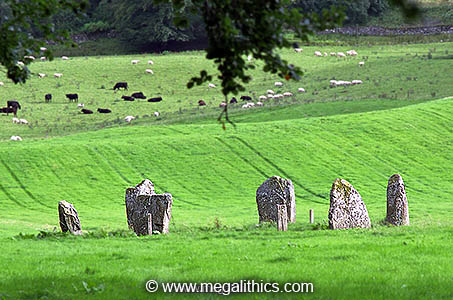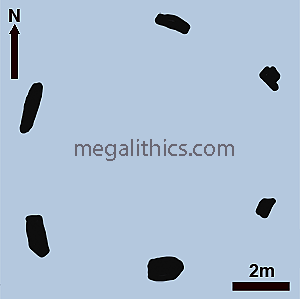

 |
 |
|
Photo Gallery |
|
|
VR Panoramas |
||
|
|
Antiquarian |
||
| NN577 328 (Pub) | Diameter 10.0 x 8.5m (Pub.) |
| Visited Sept 2001 | Magnetism not tested. |
There is some confusion concerning the name of this ring, it stands only 100m from Kinnell House and Fred Coles (1) refers to it as "the stone circle at Kinnell". Killin is the name of the village some 500m away to the NW, and several modern authors use "Killin" as the name for this circle, so to avoid confusion we have listed it in our index under both names. Whatever the name used for it, this circle stands on the south bank of the river Dochart overlooking its outflow into the SW end of Loch Tay. As mentioned above, the circle stands only 100m from Kinnell House on the estate of the same name, the area currently being parkland/grazing.
The earliest account we can find for Killin is by the Rev. Hugh Macmillan (2) in 1884 who described the ring as "a small, though well-formed and compact so-called Druidical circle, consisting of some seven or eight tall massive stones, with a few faint cup-marks on one of them, all standing upright". Macmillan's stone count of 7-8 seems unlikely given the regular spacing, but as the site has not been excavated we can not be sure. The legendary Fred Coles (1) visited the site in 1910, Fred was particularly impressed with the panoramic views from the location, unfortunately given the likely tree cover at the time of construction it is unlikely that the builders would have enjoyed similar vistas. Fred records that one stone was partially fallen ( stone 5, his stone "A"), but this stone now stands upright and must have been re-erected some time after Fred's visit.
Killin is possibly the best preserved example of a cluster of distinctive six stone rings found almost exclusively in the west of Perthshire, exhibiting height grading and bearing cupmarks, Burl (3) speculates a relationship to the Aberdeenshire RSCs. These rings seem to become more oval and smaller in diameter the further west they are found. Killin is a typical "western" ring of small diameter, it is in fact an oval of around 10 x 8.5m , the exact dimensions vary slightly with author although Thom's (4) plan is possibly the most accurate. The stones show a grading to the SW and this grading is emphasised not by unusually tall stones, but rather by the diminutive members, the three southern stones are all about 1.9m tall, the northern three dip down gradually to the east, the shortest at the NE being only 1.2m tall. The northern stone is claimed to bear between 3 and 4 cup marks, pressed for time, we could not find them, Fred Coles presumably with much more time than us, could not either.
Our visit to the Killin ring was unfortunately very brief so our coverage of the ring is not typical of us for this date, in addition we lost a roll of film for this site, so we have no detailed shots of the individual stones, etc.
1. Coles F., Proceedings of the Society of Antiquaries of Scotland,
44, p130-3, 1909-10.
2. Macmillan H., Proceedings of the Society of Antiquaries of Scotland, 18, p373-4,
1883-4.
3.
Burl A.
The Stone Circles of Britain, Ireland and Brittany,
p.191-2, Yale University Press, 1979,
Newhaven & London.
4. Thom A., Thom A.S.,
Megalithic Rings, B.A.R. 81, p.330-1,1980,
Oxford.